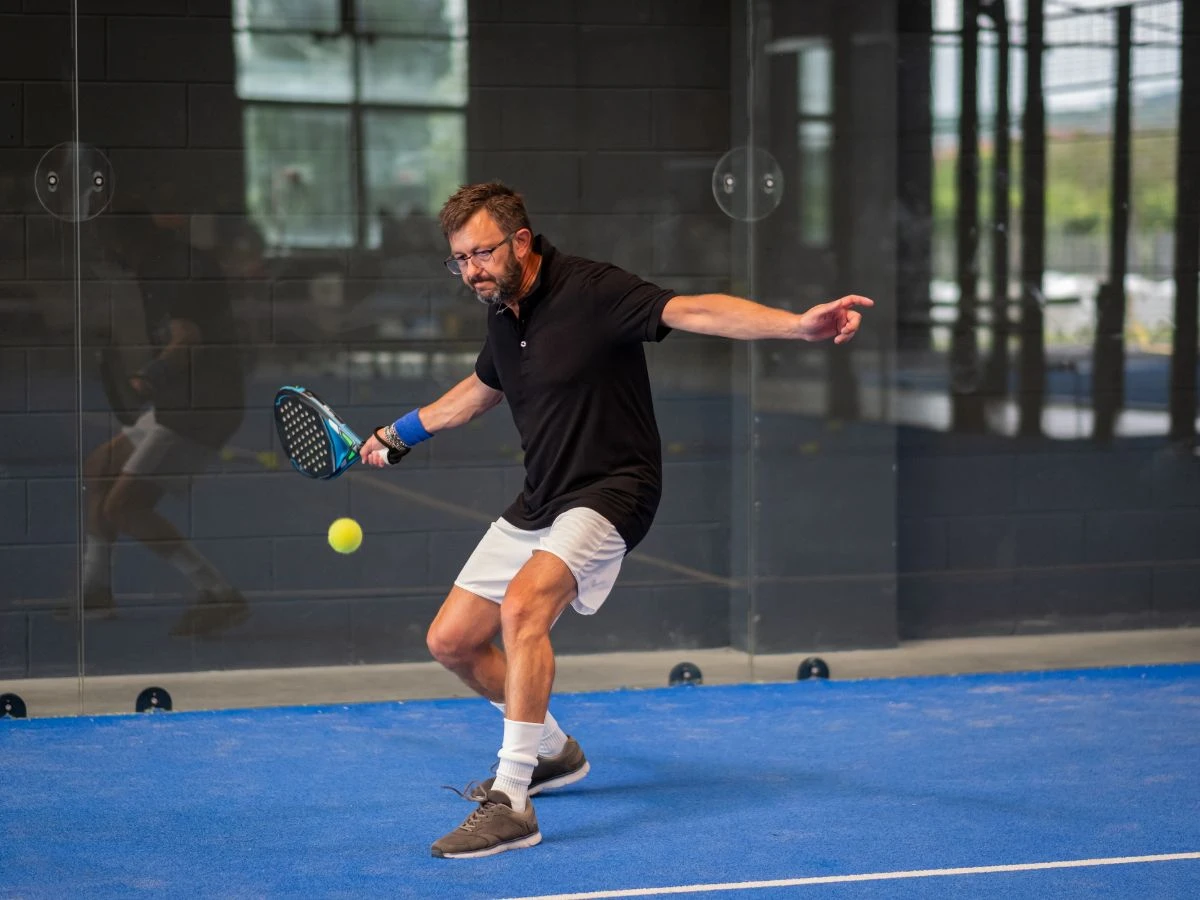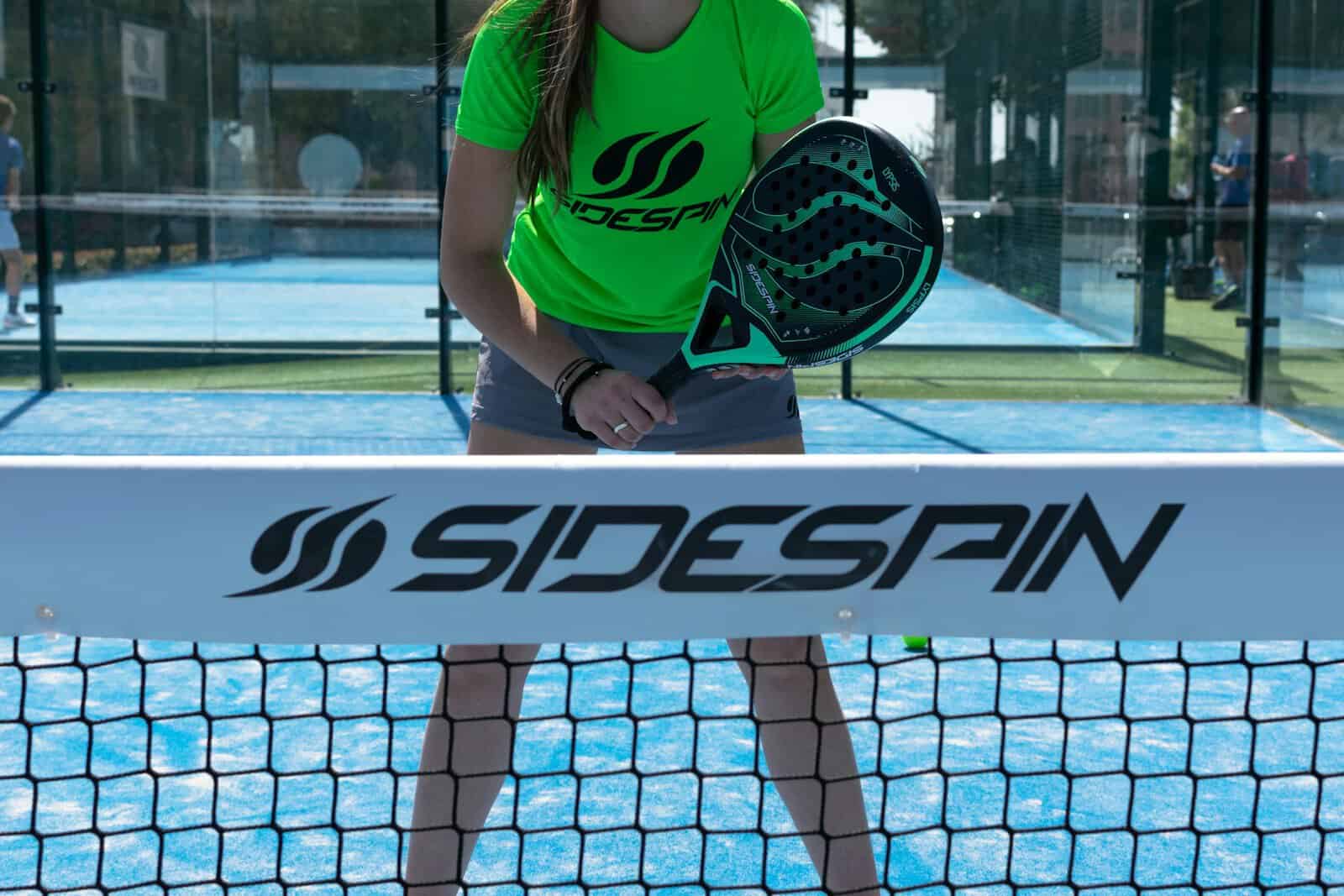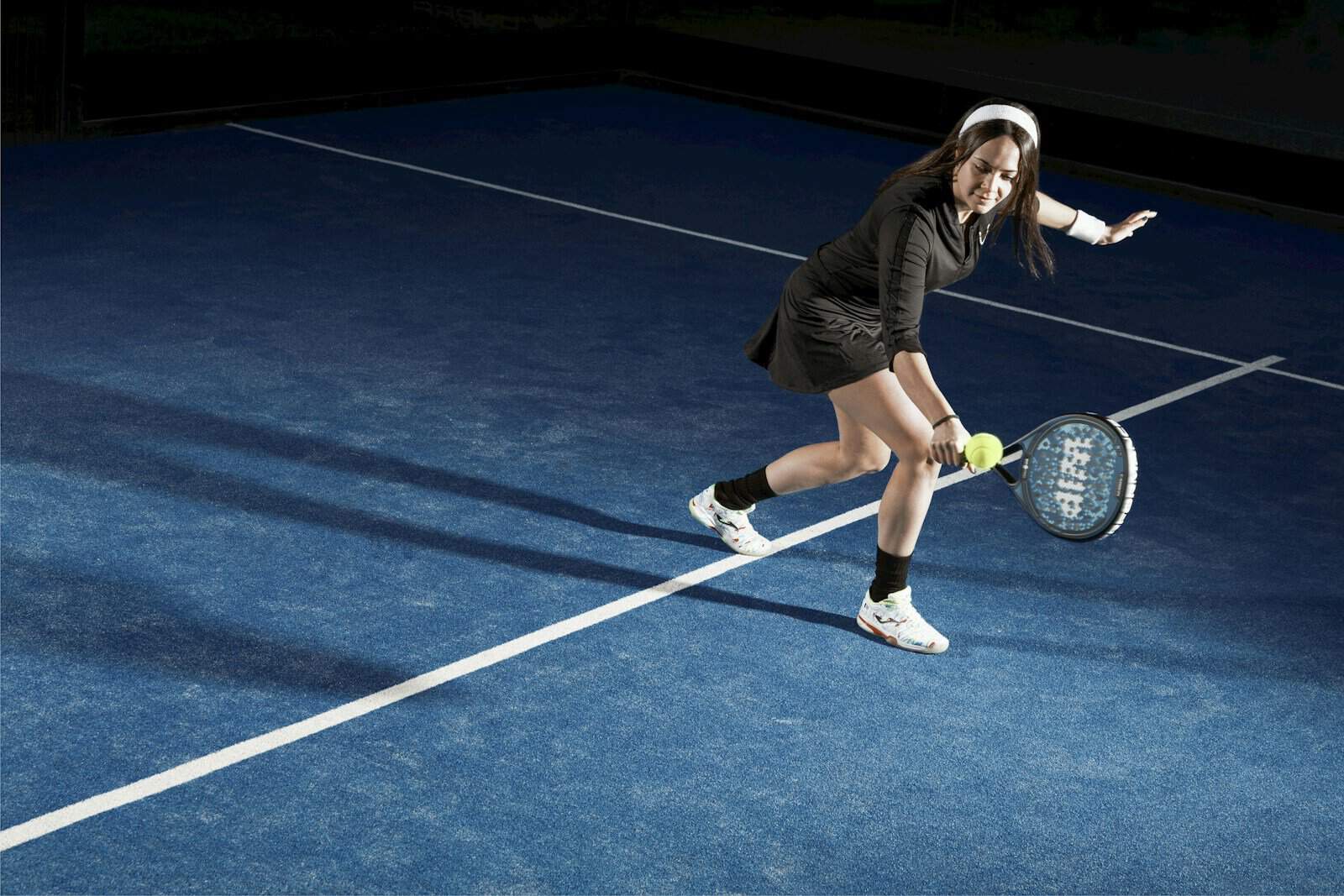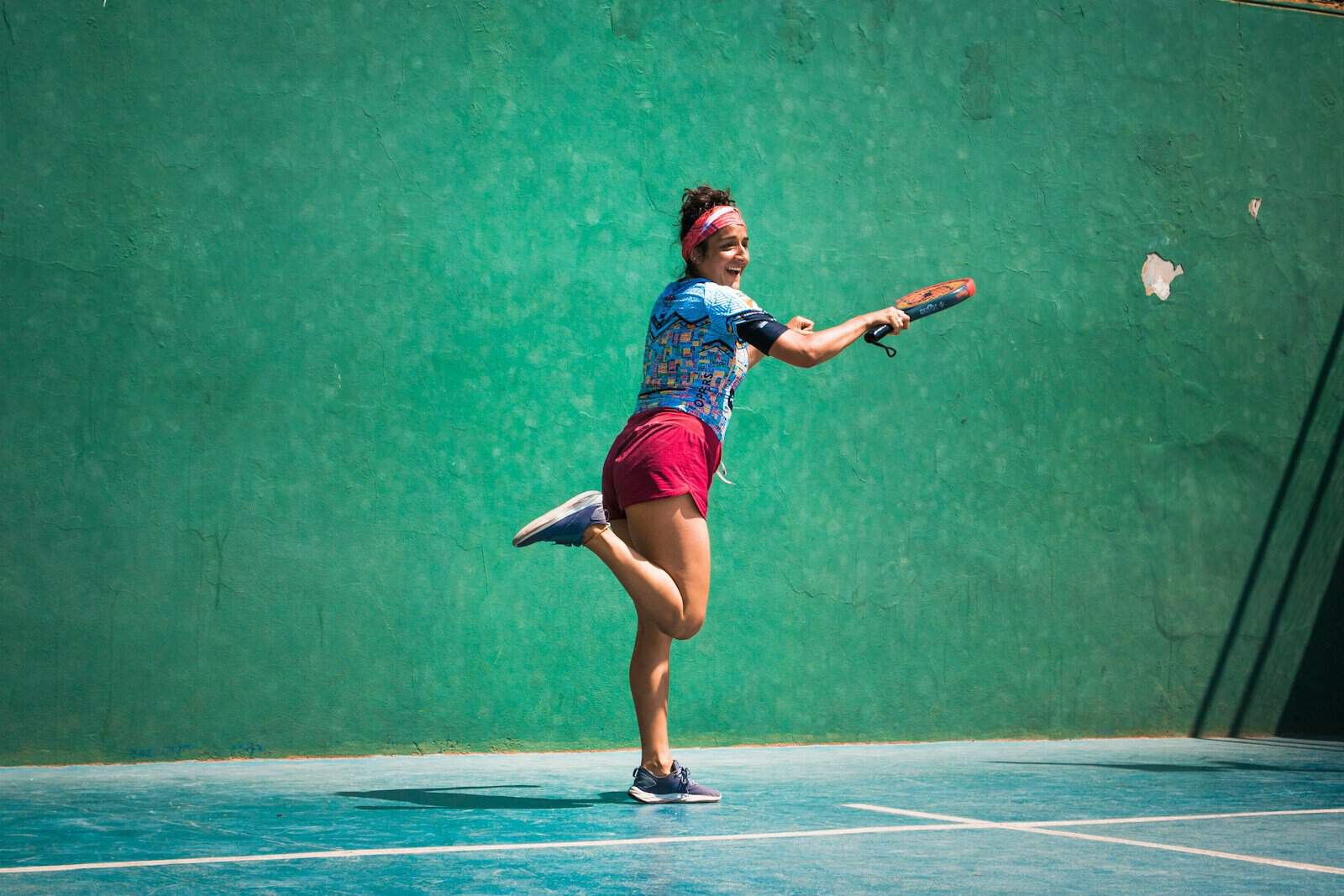Have you heard about the sport taking the world by storm? Padel tennis is a mix of tennis and squash quickly gaining fans worldwide.
It’s a fun, social game that’s easy to pick up but hard to master.
Padel is played on a smaller court than tennis, enclosed by walls that you can use in gameplay.
You’ll use a special padel and a low-pressure ball to hit shots over the netThe Net in padel is the barrier that divides the court into two halves. It’s lower than a tennis n… More and off the walls.
The scoring is like tennis, but the tactics are unique to Padel.
You don’t need to be super fit or skilled to enjoy padel.
It’s a great way to stay active and make new friends. The game suits all ages and abilities, making it a perfect choice for family outings or casual games with mates.
Ready to give it a go?
Origins and History of Padel Tennis
Padel tennis has an interesting backstory that spans several decades and countries. Its creation and spread show how a simple idea can turn into a popular sport played worldwide.
Inception and the Role of Enrique Corcuera
Padel Tennis was born in Acapulco, Mexico, in 1969.
Enrique Corcuera, a wealthy Mexican businessman, came up with the idea. He wanted a fun racquet sport that could fit in a small space.
Corcuera built the first padel court at his home. He created the game by combining parts of tennis and squash.
The court had walls you could play off of, like in squash. But it used tennis-like racquets and scoring.
The sport quickly caught on with Corcuera’s friends and family. They loved how easy it was to learn and how much fun it was to play.
Global Expansion and International Padel Federation
Padel tennis soon spread beyond Mexico. In the 1970s, a Spanish prince, Alfonso de Hohenlohe played padel at Corcuera’s home.
He loved it so much that he brought the sport to Spain.
Spain became a hotbed for padel, which grew quickly there and in nearby countries. Argentina also played a big role in padel’s growth, helping make the sport more professional.
In 1991, the International Padel Federation was formed. This group helped create standard rules and organize big tournaments.
Today, padel is played in over 90 countries. It’s especially popular in Spain, Argentina, and other parts of Europe and South America.
Understanding the Game of Padel
Padel combines elements of tennis and squash, creating a unique and exciting sport. The game is easy to learn but challenging to master, with its own set of rules and equipment.
Padel Versus Tennis and Squash
Padel shares similarities with both tennis and squash, but has its own distinct features.
Like tennis, it’s played on a rectangular court with a netThe Net in padel is the barrier that divides the court into two halves. It’s lower than a tennis n… More. However, like squash, the court is enclosed by walls. You can play shots off these walls, adding a new dimension to the game.
The scoring system in Padel is identical to tennis. But the serveThe Serve is the shot that starts the point in padel. It’s hit underhand, with the ball being stru… More is underhand, and you must let the ball bounce before returning it.
Unlike tennis, power isn’t the main focus—instead, padel rewards strategy and precise shot placement.
Padel rackets are solid and stringless, unlike tennis racquets. They’re smaller and easier to handleThe Handle of a padel racket is the part that players grip. It’s typically covered with an overgri… More, making the game more accessible to beginners.
Fundamental Rules of Padel
In padel, you play in teams of two. The scoring system mirrors tennis, with games, sets, and matches.
You serveThe Serve is the shot that starts the point in padel. It’s hit underhand, with the ball being stru… More underhand, diagonally across the court. The ball must bounce once in the service boxThe Service Box is the area of the court where the serve must land to be considered in play. It’s … More before your opponent can hit it.
After the serveThe Serve is the shot that starts the point in padel. It’s hit underhand, with the ball being stru… More, the ball can hit the ground once before you returnIn padel, a Return is the shot made after receiving a serve. A strong return can immediately put pre… More it.
You can play the ball off the walls on your side of the court, but it must clear the netThe Net in padel is the barrier that divides the court into two halves. It’s lower than a tennis n… More and land in your opponent’s court.
If the ball touches the wall on your opponent’s side before bouncing, it’s out. You lose the point if the ball bounces twice on your side or if you hit the netThe Net in padel is the barrier that divides the court into two halves. It’s lower than a tennis n… More.
Court Specifications and Equipment
A padel court is smaller than a tennis court, measuring 10m wide and 20m long.
It’s enclosed by walls made of glass and mesh, typically 3m high at the ends and 2m on the sides.
The netThe Net in padel is the barrier that divides the court into two halves. It’s lower than a tennis n… More divides the court in half, standing 88cm high at the centre. The service boxes are 6.95m long and 5m wide.
Padel rackets are solid and perforated, usually made of carbon fibreCarbon fibres are a material commonly used in the construction of high-quality padel rackets. This … More or fibreglassFibreglass is another material used in the construction of padel rackets. It’s often used in combi… More.
They’re shorter and more manoeuvrable than tennis racquets.
Padel ballsPadel Balls are specifically designed for the game, similar to tennis balls but slightly smaller and… More are similar to tennis balls but have less pressure, making them bounce lower. This design suits the smaller court and encourages strategic play.
Playing Padel Tennis
Padel tennis combines elements of tennis and squash, creating a unique and exciting racket sport. It requires quick reflexes, strategic thinking, and teamwork.
Basic Techniques and Strategies
To play Padel, you’ll need to master a few key techniques.
The serveThe Serve is the shot that starts the point in padel. It’s hit underhand, with the ball being stru… More is crucial – you must bounce the ball on your side before hitting it diagonally across the netThe Net in padel is the barrier that divides the court into two halves. It’s lower than a tennis n… More.
During rallies, you can use the glass walls to your advantage. Aim for low, angled shots that force your opponents to hit upwards.
Volleys are common in padel, so practise your netThe Net in padel is the barrier that divides the court into two halves. It’s lower than a tennis n… More play.
When defending, position yourself and your partner in a way that covers the court effectively.
Communication with your teammate is vital for successful doubles play.
Strategy involves mixing up your shots to keep opponents guessing. Use lobs to push them back, then follow up with drop shots to catch them off-guard.
Scoring System and Competition Formats
Padel uses a scoring system similar to tennis.
Matches are typically played as best-of-three sets, with the first team to reach six games winning each set.
If the score reaches 6-6, a tiebreak decides the set.
Games follow the familiar 15-30-40-game point structure. You must win by two clear points to claim a game.
In professional tournaments like the World Padel Tour or Premier Padel, matches can be intense and closely fought.
Competition formats vary. Some tournaments use a round-robin system, while others employ knockout stages.
Doubles is the standard format, but some events also feature mixed doubles.
Physical and Skill Requirements for Players
Padel demands a mix of physical attributes and technical skills.
You’ll need good hand-eye coordination and quick reflexes to handleThe Handle of a padel racket is the part that players grip. It’s typically covered with an overgri… More fast-paced rallies and rebounds off the walls.
Agility is crucial for covering the court and reaching difficult shots.
While the court is smaller than a tennis court, you’ll still need decent stamina to compete in long matches.
Key skills to develop include:
- Accurate groundstrokes
- Solid volleying technique
- Effective use of the walls
- Tactical awareness
Regular training can help improve these abilities.
Focus on drills that enhance your shot precision and court movement.
As you progress, work on reading your opponents’ shots and anticipating their strategies.
Padel Tennis Equipment Details
Padel tennis requires specific gear to play effectively. The right equipment can improve your game and make it more enjoyable. Let’s look at the key items you’ll need.
Choosing the Right Padel Racket
Padel rackets come in different shapes and materials.
The two main shapes are drop-shaped and diamond-shaped. Drop-shaped rackets offer more control, while diamond-shaped ones give more power.
Most rackets are made of carbon fibreCarbon fibres are a material commonly used in the construction of high-quality padel rackets. This … More or fibreglassFibreglass is another material used in the construction of padel rackets. It’s often used in combi… More. Carbon fibreCarbon fibres are a material commonly used in the construction of high-quality padel rackets. This … More is lighter and offers more power. FibreglassFibreglass is another material used in the construction of padel rackets. It’s often used in combi… More is more flexible and gives better control.
When choosing a racket, consider your playing style and skill level. Beginners might prefer a more balanced racket, while advanced players may opt for specialised designs.
Types of Balls and Their Properties
Padel ballsPadel Balls are specifically designed for the game, similar to tennis balls but slightly smaller and… More look similar to tennis balls but have less pressure. This makes them bounce less, which suits the smaller court and glass walls.
There are three main types of padel ballsPadel Balls are specifically designed for the game, similar to tennis balls but slightly smaller and… More:
- Pressurised balls: These are the most common. They offer good bounce and durability.
- Pressureless balls: These last longer but have less bounce.
- Training balls: These are softer and ideal for beginners or practice sessions.
The colour of padel ballsPadel Balls are specifically designed for the game, similar to tennis balls but slightly smaller and… More is usually yellow, but you might find some in other bright colours.
Always check that the balls you use are approved for official play if you’re in a competition.
Additional Gear and Accessories
Proper footwear is crucial in padel. Padel shoes are designed for quick lateral movements and have soles that grip well on the court surfaceThe Court Surface in padel is typically made of synthetic grass or turf, providing the right balance… More.
Comfortable clothing that allows free movement is important. Many players wear tennis-style outfits.
Other useful accessories include:
- Overgrips to improve racket handleThe Handle of a padel racket is the part that players grip. It’s typically covered with an overgri… More grip
- Wristbands to absorb sweat
- A sports bag to carry your gear
- A water bottle to stay hydrated during play
Don’t forget eye protection. The glass walls can cause unexpected ball rebounds, so some players wear sports goggles for safety.
The Social and Cultural Impact of Padel
Padel has quickly become a sport that brings people together. Its unique blend of tennis and squash elements has captured the hearts of players and fans across different cultures.
Padel’s Rise in Popularity
Padel’s popularity is soaring worldwide. It’s one of the fastest-growing sports, especially in Spain, where it’s second only to football.
The game’s appeal lies in its easy-to-learn nature, making it accessible to players of all skill levels.
In recent years, padel courts have popped up in parks, sports clubs, and even private homes. This rapid growth is fuelled by the sport’s social aspect and the fun it offers to players of all ages.
Celebrity endorsements have also boosted padel’s profile. You might spot famous footballers and tennis stars picking up a padel racquet in their free time, further increasing the sport’s visibility.
Influence in Europe and North America
Padel’s influence is spreading beyond its stronghold in Spain. You’ll see its impact growing across Europe, with countries like Sweden, Italy, and France embracing the sport.
In the UK, padel is gaining traction rapidly. Courts are now located in major cities, and the number of players is increasing yearly.
North America is also catching padel fever. While it’s still in its early stages, more courts appear in the US and Canada. The sport’s social nature and ease of play are driving its adoption in these regions.
Padel as a Family and Community Sport
Padel’s accessibility makes it an ideal family sport. You can enjoy a game with your children, parents, or grandparents, regardless of age or fitness level.
Its smaller court size and the use of walls make rallies longer and more enjoyable for all.
Communities are also benefiting from padel. You’ll find it brings neighbours together, fostering new friendships and strengthening existing ones. Local tournaments and leagues are becoming common, creating a sense of belonging among players.
Padel clubs often become social hubs, where you can meet new people, exercise, and have fun. The sport’s doubles format encourages interaction and teamwork, making it a perfect activity for building relationships.
Professional Padel Scene
The professional padel scene thrives with exciting tournaments, top-ranked athletes, and a push for Olympic recognition. You’ll find a mix of established events and emerging stars shaping the sport’s future.
Major Tournaments and the Padel Pro Tour
The World Padel Tour is the premier circuit for professional padel players. It features a series of tournaments across different countries, attracting the best talent globally.
The tour’s prize pool exceeds €4 million, showcasing the sport’s growing financial appeal.
Tournaments are categorised into different levels, including:
- Master Finals
- Master
- Open
- Challenger
These events offer varying points and prize money, creating a competitive atmosphere for players at different stages of their careers.
Rankings and Notable Padel Athletes
Professional padel rankings are based on players’ performances in official tournaments. The World Padel Tour maintains separate rankings for men and women.
Top-ranked players often become household names in padel-loving countries. Some notable athletes include:
- Juan Lebrón (Spain)
- Alejandra Salazar (Spain)
- Fernando Belasteguín (Argentina)
- Gemma Triay (Spain)
These players showcase exceptional skill, strategy, and athleticism, inspiring new generations of padel enthusiasts.
The Path to Becoming an Olympic Sport
Padel is making strides towards Olympic recognition. The International Padel Federation (FIP) is working to meet the International Olympic Committee (IOC) criteria.
Key steps in this process include:
- Increasing global participation
- Standardising rules and regulations
- Enhancing anti-doping measures
- Boosting media coverage and sponsorship
While not yet an Olympic sport, padel’s rapid growth and popularity suggest it could be a strong contender for future Games. The sport’s inclusion would significantly boost its profile and attract more players and fans worldwide.
Learning and Training for Padel
Padel is an easy-to-learn sport that offers many ways to improve your skills. There are plenty of options for training and developing your game.
Clubs and Facilities for Practice
Many sports centres now offer padel courts. You can find dedicated padel clubs in cities across the UK.
These facilities often have both indoor and outdoor courts. Some clubs provide equipment rental, so you don’t need to buy your racket right away.
Booking a court is usually simple. Many clubs use online systems where you can reserve a time slot.
Practice sessions typically last an hour. This gives you enough time to warm up and play several games.
Some facilities offer open play sessions. These are great for meeting other players and arranging matches.
Coaching and Development Programmes
Padel coaching is widely available for all skill levels.
Coaches can help you master key techniques like volleys, lobs, and rallies.
Many clubs run group lessons for beginners. These are a cost-effective way to learn the basics.
For more advanced players, one-on-one coaching is an option.
These sessions focus on improving specific aspects of your game. Some coaches use video analysis to help you refine your technique.
Development programmes often include fitness training. This helps improve your speed and agility on the court.
Many clubs also organise internal leagues and tournaments.
Community Engagement and Beginner Support
Padel has a strong community spirit. Many clubs host social events and beginner-friendly sessions.
These are great ways to meet other players and practice in a relaxed setting.
Some facilities offer ‘padel buddies’ programmes. These pair new players with more experienced ones for casual games.
It’s a fun way to learn and make friends.
Online forums and social media groups are also popular. You can use these to find playing partners, get tips, and stay updated on local events.
Many beginners find these communities helpful for getting started and staying motivated.




